Here you can find a list of all the research found on the Arc Diagram.
An Arc Diagram is a visualisation that displays nodes placed along a single line for a one-dimensional axis and connects the nodes with arcs to show the relationship between the nodes.
A lot of the papers here are focused on the mathematical side of Arc Diagrams and look at subjects such as graph theory and combinatorics rather than purely on data visualisation. Since mathematics is not my area of expertise and not relevant to my research, I haven’t read into those papers in much depth. However, I have still included them as they may be of use to programmers looking to build Arc Diagrams.
To distinguish between data visualisation research and other subjects, I will label each as such to ease referencing.
If I’ve missed any relevant papers, then please get in touch or post in the comments below.
The Minimum Number of Intersections in Complete Graphs (1964)
By Thomas L. Saaty
Topic: Mathematics
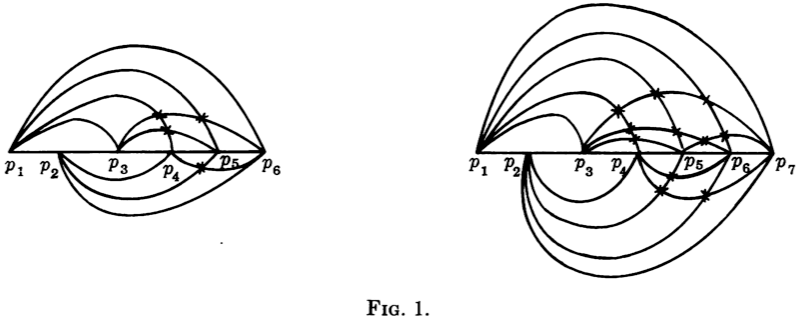
The first appearance of an Arc Diagram can be found in Fig 1, p. 689 in this mathematical study into crossing numbers of graphs.
https://doi.org/10.1073/pnas.52.3.688
Arc Diagrams: Visualizing Structure in Strings (2002)
By Martin Wattenberg
Topic: Data Visualisation
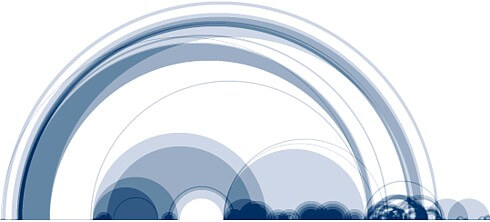
This is the first paper that applies Arc Diagrams to data visualisation to visualise music data. The results of this research can be seen in the project The Shape of Song (2002).
https://doi.org/10.1109/INFVIS.2002.1173155
Thread Arcs: an email thread visualization (2003)
By Bernard Kerr
Topic: Data Visualisation

The research done here explores using Arc Diagrams to visualise e-mail threads chronologically. Thread Arcs reveals both the relationships between messages and the overall structure of message threads.
https://doi.org/10.1109/INFVIS.2003.1249028
Visualising Bluetooth Interactions (2007)
By Daragh Byrne, Barry Lavelle, Gareth J.F. Jones, Alan F. Smeaton
Topic: Data Visualisation
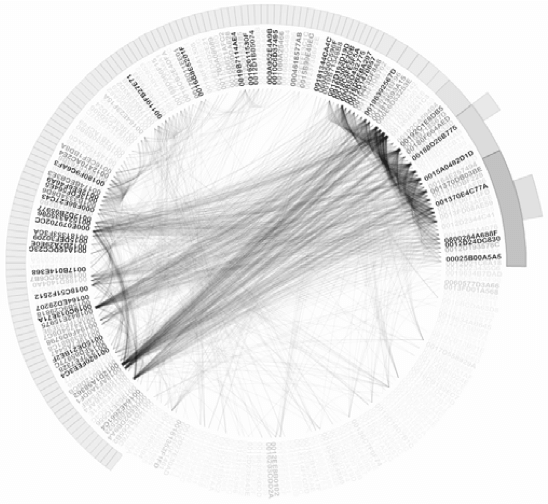
Designed in this paper is a visualisation that combines Arc Diagrams with the DocuBurst technique to convey a rich understanding of Bluetooth interaction data. The resulting visualisation is essentially a non-ribbon Chord Diagram and not an Arc Diagram. However, this visualisation enables the visual analysis of the relative importance of individual devices encountered, along with the relationships established between them and the usage of Bluetooth “friendly names” within the data.
https://dl.acm.org/doi/abs/10.5555/1531407.1531441
Transat—A Method for Detecting the Conserved Helices of Functional RNA Structures, Including Transient, Pseudo-Knotted and Alternative Structures (2010)
By Nicholas J. P. Wiebe and Irmtraud M. Meyer
Topic: Computational Biology
https://doi.org/10.1371/journal.pcbi.1000823

R-CHIE : a web server and R package for visualizing RNA secondary structures (2012)
By Daniel Lai, Jeff R. Proctor, Jing Yun A. Zhu, Irmtraud M. Meyer
Topics: Data Visualisation, Computational Biology

The companion paper to the R package and web server used to visualise and examine RNA structures. This paper carries on from the previous Transat paper and examines the use of Arc Diagrams in visualising RNA secondary structure. R-chie can be downloaded from: https://www.e-rna.org/r-chie/
https://doi.org/10.1093/nar/gks241
Visualizations for Exploration of American Football Season and Play Data (2013)
By Sean Gabriel Owens and T.J. Jankun-Kelly
Topic: Data Visualisation
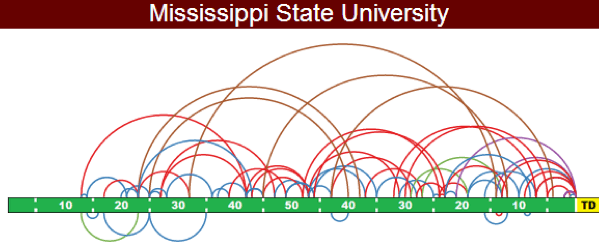
This paper explores the visualisation of American Football data through the use of two chart types: a Parallel Coordinates Plot for analysing season-long data and an Arc Diagram to visualise all of the plays (discrete actions) that occur in a single football game.
https://workshop.sportvis.com/papers/owens_jankun-kelly_paper.pdf
A Visual Survey of Arc Diagrams (2013)
By Till Nagel and Erik Duval
Topic: Data Visualisation

This paper catalogues a collection of popular Arc Diagram examples and classifies them into primary and secondary categories based on various characteristics and construction choices. The result of this survey is a poster containing a meta-visualisation, which can be viewed here: https://github.com/tillnagel/ArcSurvey
https://uclab.fh-potsdam.de/wp/wp-content/uploads/2013-a-visual-survey-of-arc-diagrams.pdf
Achieving Good Angular Resolution in 3D Arc Diagram (2013)
By Michael T. Goodrich and Paweł Pszona
Topics: Mathematics, Computer Science
https://doi.org/10.1007/978-3-319-03841-4_15
Arc diagram varieties (2014)
By Justyna Kosakowska and Markus Schmidmeier
Topic: Mathematics
https://doi.org/10.1090/conm/607/12088
Operations on arc diagrams and degenerations for invariant subspaces of linear operators (2014)
By Justyna Kosakowska and Markus Schmidmeier
Topic: Mathematics
https://doi.org/10.1090/S0002-9947-2014-06206-5
Noncrossing Arc Diagrams and Canonical Join Representations (2015)
By Nathan Reading
Topic: Mathematics
https://doi.org/10.1137/140972391
Visualizing ncRNA Structural Evolution with Arc Diagrams (2015)
By Alyssa Tsiros and Lane Harrison
Topics: Data Visualisation, Computational Biology
This paper documents a project for a BioVis Symposium design contest whose challenge was to create a visualization of noncoding RNA structural evolution of the human accelerated region 1 (HAR1) gene in ancestral, Denisovan, and human sequences. The authors selected an Arc Diagram to highlight conserved or otherwise evolved base pairings, as this visualisation seems to provide more emphasis to visual features needed for the task of analysing evolution sequences.
http://biovis.net/sites/default/files/1_Alyssa_Tsiros_0.pdf
Bijections for Weyl Chamber walks ending on an axis, using arc diagrams (2018)
By Julien Courtiela, Eric Fusy, Mathias Lepoutre, Marni Mishnac
Topic: Mathematics
https://doi.org/10.1016/j.ejc.2017.10.003
Operations on arc diagrams and degenerations for invariant subspaces of linear operators. Part II (2016)
By Mariusz Kaniecki, Justyna Kosakowska, Markus Schmidmeier
Topic: Mathematics
https://doi.org/10.1080/00927872.2017.1376212
Arc diagrams, flip distances, and Hamiltonian triangulations (2018)
By Jean Cardinal, Michael Hoffmann, Vincent Kusters, Csaba D. Tóth, Manuel Wettstein
Topic: Mathematics
https://doi.org/10.1016/j.comgeo.2017.06.001
Hopf algebras on decorated noncrossing arc diagrams (2019)
By Vincent Pilaud
Topic: Mathematics
https://doi.org/10.1016/j.jcta.2018.09.005
Parallel Arc Diagrams: Visualizing Temporal Interactions (2020)
By Peter Hoek
Topic: Data Visualisation
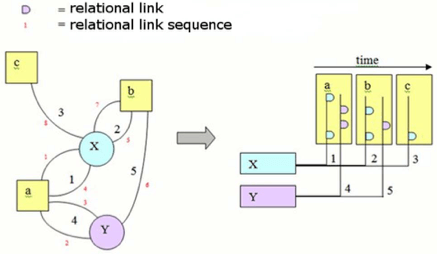
In this paper, Hoek introduces a new visualisation called the “Parallel Arc Diagram” as an alternative to node-link diagrams for social network analysis.
https://doi.org/10.21307/joss-2019-036
Monotone Arc Diagrams with few Biarcs (2020)
By Steven Chaplick, Henry Förster, Michael Hoffmann, Michael Kaufmann
Topic: Mathematics
https://arxiv.org/abs/2003.05332
Catalan triangles and tied arc diagrams (2020)
By Francesca Aicardi
Topic: Mathematics
https://arxiv.org/abs/2011.14628
Lifting Arc Diagrams Under Branched Covers: An Inverse Problem and its Solution (2020)
By Cyrus Peterpaul
Topic: Mathematics
https://arxiv.org/abs/2009.05608
Arc diagrams and 2-term simple-minded collections of preprojective algebras of type A (2021)
By Yuya Mizuno
Topic: Mathematics
https://doi.org/10.1016/j.jalgebra.2021.12.029
Visualizing Intertextual Form with Arc Diagrams: Contour and Schema-based Methods (2021)
By Aaron Carter-Enyi, Gilad Rabinovitch, Nathaniel Condit-Schultz
Topics: Data Visualisation, Music
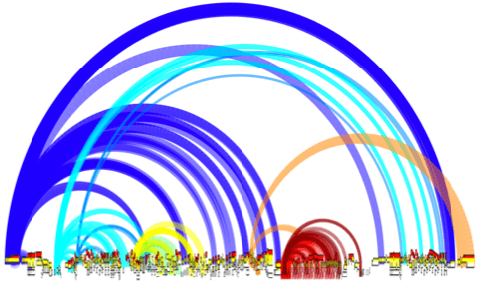
Inspired by the research done by Wattenberg on using Arc Diagrams for visualising music, this paper examines the use of other methods to visualise songs. The goal is to compare and analyse music across genres and cultures (primarily classical European music to African).
